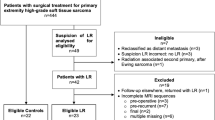Abstract
Objective
Electron beam therapy is a definitive radiation treatment option for superficial fibromatoses of the hands and feet. Because objective criteria for treatment response remain poorly defined, we sought to describe changes in electron beam treated lesions on MRI.
Materials and methods
The study included 1 male and 9 female patients with a total of 37 superficial fibromatoses; average age was 60.7 years. Standard 6 MeV electron beam treatment included 3 Gy per fraction for 10 or 12 treatments using split-course with 3-month halfway break. Pre- and post-treatment MRIs were evaluated to determine lesion size (cm3), T2 signal intensity and contrast enhancement (5-point ordinal scales) by a fellowship trained musculoskeletal radiologist. MRI findings were correlated with clinical response using a composite 1–5 ordinal scale, Karnofsky Performance Scale and patient-reported 10-point visual analog scale for pain.
Results
Mean volume decreased from 1.5 to 1.2 cm3 (p = 0.01, paired t-test). Mean T2 hyperintensity score decreased from 3.0 to 2.1 (p < 0.0001, Wilcoxon signed-rank). Mean enhancement score available for 22 lesions decreased from 3.8 to 3.0 (p < 0.0001, Wilcoxon signed-rank). Performance scores improved from 78.9 ± 13.7 to 84.6 ± 6.9 (p = 0.007, paired t-test). Pain scores decreased from 3.0 ± 3.3 to 1.1 ± 2.0 (p = 0.0001, paired t-test). Post-treatment T2 signal correlated weakly with performance and pain (Spearman’s ρ = −0.37 and 0.16, respectively).
Conclusions
MRI is valuable for evaluating patients undergoing electron beam therapy for superficial fibromatoses: higher pretreatment T2 intensity may predict benefit from radiotherapy. T2 hypointensity may be a better marker than size for therapeutic effect.









Similar content being viewed by others
References
Bayat A, McGrouther DA. Management of Dupuytren’s disease: clear advice for an elusive condition. Ann R Coll Surg Engl. 2006;88(1):3–8.
Jo VY, Fletcher CDM. WHO classification of soft tissue tumours: an update based on the 2013 (4th) edition. Pathology (Phila). 2014;46(2):95–104.
Murphey MD, Ruble CM, Tyszko SM, Zbojniewicz AM, Potter BK, Miettinen M. Musculoskeletal Fibromatoses: radiologic-pathologic correlation. Radiographics. 2009;29(7):2143–83.
Goldblum JR, Folpe AL, Weiss SW, Enzinger FM, Weiss SW. Enzinger and Weiss’s soft tissue tumors. 6th ed. Philadelphia: Saunders/Elsevier; 2014. 1155 pp
Murrell GA. The role of the fibroblast in Dupuytren’s contracture. Hand Clin. 1991;7(4):669–80. discussion 681
Tomasek JJ, Vaughan MB, Haaksma CJ. Cellular structure and biology of Dupuytren’s disease. Hand Clin. 1999;15(1):21–34.
Seegenschmiedt MH, Micke O, Niewald M, Mücke R, Eich HT, Kriz J, et al. DEGRO guidelines for the radiotherapy of non-malignant disorders : part III: hyperproliferative disorders. Strahlenther Onkol Organ Dtsch Rontgengesellschaft Al. 2015;191(7):541–8.
Ball C, Izadi D, Verjee LS, Chan J, Nanchahal J. Systematic review of non-surgical treatments for early Dupuytren’s disease. BMC Musculoskelet Disord. 2016;17(1):345.
Heyd R, Dorn AP, Herkströter M, Rödel C, Müller-Schimpfle M, Fraunholz I. Radiation therapy for early stages of morbus Ledderhose. Strahlenther Onkol Organ Dtsch Rontgengesellschaft Al. 2010;186(1):24–9.
Zirbs M, Anzeneder T, Bruckbauer H, Hofmann H, Brockow K, Ring J, et al. Radiotherapy with soft X-rays in Dupuytren’s disease: successful, well-tolerated and satisfying. J Eur Acad Dermatol Venereol JEADV. 2015;29(5):904–11.
Rubin P, Soni A, Williams JP. The molecular and cellular biologic basis for the radiation treatment of benign proliferative diseases. Semin Radiat Oncol. 1999;9(2):203–14.
Seegenschmiedt MH, Adamietz B, editors. Radiotherapy for non-malignant disorders. Berlin: Springer; 2008. 743 p.
Ball C, Pratt AL, Nanchahal J. Optimal functional outcome measures for assessing treatment for Dupuytren’s disease: a systematic review and recommendations for future practice. BMC Musculoskelet Disord. 2013;14:131.
Walker EA, Petscavage JM, Brian PL, Logie CI, Montini KM, Murphey MD. Imaging features of superficial and deep fibromatoses in the adult population. Sarcoma. 2012;2012:215810.
Sheth PJ, Del Moral S, Wilky BA, Trent JC, Cohen J, Rosenberg AE, et al. Desmoid fibromatosis: MRI features of response to systemic therapy. Skelet Radiol. 2016;45(10):1365–73.
Lee JC, Thomas JM, Phillips S, Fisher C, Moskovic E. Aggressive fibromatosis: MRI features with pathologic correlation. AJR Am J Roentgenol. 2006;186(1):247–54.
Murphey MD, Ruble CM, Tyszko SM, Zbojniewicz AM, Potter BK, Miettinen M. From the archives of the AFIP: musculoskeletal fibromatoses: radiologic-pathologic correlation. Radiogr Rev. 2009;29(7):2143–73.
Robbin MR, Murphey MD, Temple HT, Kransdorf MJ, Choi JJ. Imaging of musculoskeletal fibromatosis. Radiographics. 2001;21(3):585–600.
Evans JD. Straightforward statistics for the behavioral sciences. Pacific Grove: Brooks/Cole; 1996. 600 p.
Ketchum LD. The rationale for treating the nodule in Dupuytren’s disease. Plast Reconstr Surg Glob Open. 2014;2(12):e278.
Badalamente MA, Hurst LC. Efficacy and safety of injectable mixed collagenase subtypes in the treatment of Dupuytren’s contracture. J Hand Surg. 2007;32(6):767–74.
Denkler K. Surgical complications associated with fasciectomy for Dupuytren’s disease: a 20-year review of the English literature. Eplasty. 2010;10:e15.
Prosser R, Conolly WB. Complications following surgical treatment for Dupuytren’s contracture. J Hand Ther. 1996;9(4):344–8.
Fenney R. Dupuytren’s contracture a radiotherapeutic approach. Lancet Lond Engl. 1953;265(6795):1064–6.
Seegenschmiedt MH, Olschewski T, Guntrum F. Radiotherapy optimization in early-stage Dupuytren’s contracture: first results of a randomized clinical study. Int J Radiat Oncol Biol Phys. 2001;49(3):785–98.
Montgomery E, Lee JH, Abraham SC, Wu TT. Superficial fibromatoses are genetically distinct from deep fibromatoses. Mod Pathol. 2001;14(7):695–701.
Dolmans GH, Werker PM, Hennies HC, Furniss D, Festen EA, Franke L, et al. Wnt signaling and Dupuytren’s disease. N Engl J Med. 2011;365(4):307–17.
Funding
No financial support was received by any author for the creation of this work.
Author information
Authors and Affiliations
Corresponding author
Ethics declarations
Conflict of interest
The authors declare that they have no conflict of interest.
Rights and permissions
About this article
Cite this article
Banks, J.S., Wolfson, A.H. & Subhawong, T.K. T2 signal intensity as an imaging biomarker for patients with superficial Fibromatoses of the hands (Dupuytren’s disease) and feet (Ledderhose disease) undergoing definitive electron beam irradiation. Skeletal Radiol 47, 243–251 (2018). https://doi.org/10.1007/s00256-017-2792-5
Received:
Revised:
Accepted:
Published:
Issue Date:
DOI: https://doi.org/10.1007/s00256-017-2792-5




